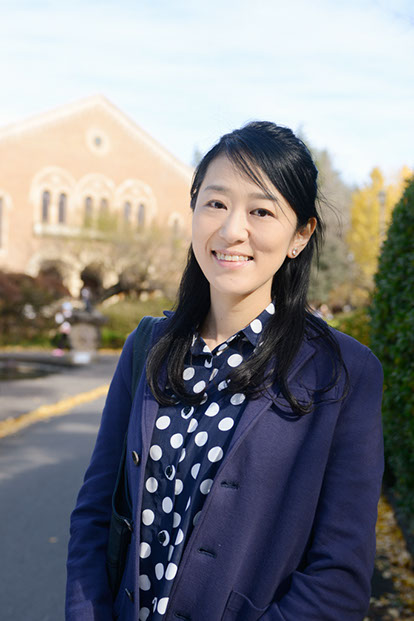
A Japanese doctor who exposed questionable claims promoted by anti-vaccine campaigners in her country has been awarded the 2017 John Maddox Prize for Standing up for Science.
Dr. Riko Muranaka, a physician and writer with Kyoto University, has been targeted with lawsuits, harassed, banned from the media and had her book withdrawn from publication after calling anti-vaccine claims made by a prestigious Japanese doctor a “fabrication.”
Muranaka told the Alliance for Science that while she is personally honored to receive the prize, she hopes it will help to get “the government and the media to change their attitude” on the human papillomavirus (HPV) vaccine issue. “Standing up for science isn’t easy, but that also brought me a lot of friends, even in the media,” she said.
The John Maddox Prize for Standing up for Science, now in its sixth year, recognizes the work of individuals anywhere in the world who promote sound science and evidence on a matter of public interest, facing difficulty or hostility in doing so. It is awarded to one or two people a year by the leading international scientific journal Nature, the Kohn Foundation, and the charity Sense about Science.
Muranaka was recognized for her efforts challenging a vociferous campaign against the HPV vaccine in Japan. Anti-vaccine activists circulated videos purporting to show young girls suffering mysterious side effects that left them wracked with pain or even wheelchair-bound after receiving the vaccine. Their activities led to a collapse in the vaccination rate, down from 70 percent in 2013 to less than 1 percent today.
The World Health Organization (WHO) estimates that 630,000 cases of HPV-related cancers occur each year, resulting in 266,000 deaths worldwide . It considers HPV vaccine to be one of the safest vaccines available, and recommends its mandatory use by governments.
However, since the HPV furor erupted in Japan, the Japanese health ministry has stopped the proactive recommendation of the vaccine, “in consideration for the victims,” while keeping it in the national immunization program. This is a fudge that has reassured no-one, according to medical experts.
Japan therefore presents an extraordinary case of a country where anti-vaccine activists effectively won the debate. Fear-mongering about HPV has subsequently spread globally, prompting fears in the medical community that it could ultimately be as damaging to public health as the manufactured controversy around the mumps-measles-rubella vaccine (MMR) and autism.
Prize-winner Muranaka spent months investigating claims by the prestigious doctor Shuichi Ikeda that the symptoms purportedly experienced by the vaccine-affected girls were real. Ikeda showed slides of mouse brains on popular TV news program, claiming that mice injected with the vaccine showed deposits of an abnormal auto-antibody.
When Muranka finally tracked down the source of the slide, the researcher involved told her the experiment had involved only one mouse being injected with each vaccine, and that the mouse brain showed by Ikeda was not even the one injected with HPV vaccine.
Muranaka also discovered that the mice vaccinated in the experiment had been genetically modified and produced an auto-antibody naturally during aging. Serum full of the antibody was taken from these mice, sprayed on brain sections of normal mice and photographed to show brain damage supposedly caused by HPV vaccine.
However, when Muranaka exposed this alleged “fabrication,” Ikeda filed a lawsuit in a Tokyo court claiming defamation. Ikeda is principal researcher of the group commissioned by the Ministry of Health, Labor and Welfare to investigate adverse reactions of the HPV vaccine, and was professor of neurology at Shinshu University. He currently runs an outpatient clinic for supposed victims of the HPV vaccine at the university hospital.
As a result of the defamation suit, Muranaka found that her written columns were dropped, she was subjected to a media blackout, and her publisher refused to release her completed book about the HPV vaccine controversy in Japan. She was also targeted by vaccine victims groups, who deluged any media outlets that reported her story with furious complaints.
“Dr. Ikeda s legal action frightened the media and they stopped using me, Muranaka said. The victims organization was very professional. Their claims didn t always go to editorial departments. They went to the president s office of the publishers stakeholders, and sometimes, they went to politicians with influence in the stakeholders business. A daughter of the governor of Tokyo, a director of NHK, the public broadcast station in Japan, and a close friend of the victims organization, was keen on finding out where I lived and who my family members were. My family and I received threatening messages.
“Publications stopped using my regular columns, she continued. They decided not to publish my book even though the publication day had been announced, my photo had been shot, and the cover design was finished. Since then, I have spoken to eight other publishers, but all of them said the same thing: It is well-written and very interesting to read, but we can t publish it now. “
Muranaka told the Alliance for Science that she found it an interesting coincidence that just two weeks after Ikeda made his inflammatory presentation about the supposed dangers of HPV vaccine, a class-action lawsuit was launched by victims groups against both the government and vaccine manufacturers.
She also drew attention to the damage caused to peoples’ lives by HPV-related cancers. “In Japan, 3,000 lives and 10,000 wombs are lost to cervical cancer every year. In Japan, a class action lawsuit is said to take 10 years, and it seems that no politician make a decision to restart the HPV vaccination until the lawsuit is over.”
“If we have to wait 10 years for any hope of HPV vaccination starting again, how many more wombs will Japanese gynecologists have to dig out? The answer is ‘100,000. Please imagine all those wombs gone. Please imagine the women who owned them, the children who were born from them and lost their mother, and the children who were supposed to be born from them.”
